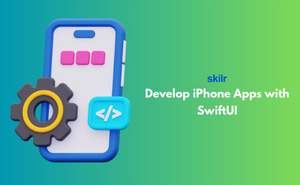👇 CELEBRATE CLOUD COMPUTING DAY 👇
00
HOURS
00
MINUTES
00
SECONDS

The SwiftUI certification for iPhone app development focuses on teaching how to design and build mobile apps using Apple’s latest tools. SwiftUI is a framework that simplifies coding by allowing developers to describe what they want on the screen instead of writing complex instructions. This approach helps create apps that are clean, fast, and user-friendly.
In other words, learning SwiftUI gives you the skills to bring your app ideas to life quickly. It ensures that your apps not only work well but also follow Apple’s design guidelines. This makes SwiftUI an essential skill for anyone looking to grow in iOS development or launch their own app projects.
This exam is ideal for:
Credentials that reinforce your career growth and employability.
Start learning immediately with digital materials, no delays.
Practice until you're fully confident, at no additional charge.
Study anytime, anywhere, on laptop, tablet, or smartphone.
Courses and practice exams developed by qualified professionals.
Support available round the clock whenever you need help.
Easy-to-follow content with practice exams and assessments.
Join a global community of professionals advancing their skills.
(Based on 666 reviews)
Anyone interested in iOS app development, from students to professionals and entrepreneurs.
Yes, animations and smooth transitions are a key part of SwiftUI.
SwiftUI is for Apple platforms (iOS, iPadOS, macOS, watchOS, tvOS).
Yes, Xcode is the primary development tool for SwiftUI.
Basic programming knowledge helps, but SwiftUI is beginner-friendly.
Yes, many developers and companies are adopting SwiftUI for new projects.
Yes, SwiftUI apps work across iPhones, iPads, and even Macs.
SwiftUI is Apple’s modern framework, simpler, and future-focused.
Yes, it covers preparing and submitting apps to the App Store.
It allows them to quickly prototype and launch app ideas without hiring a big team.